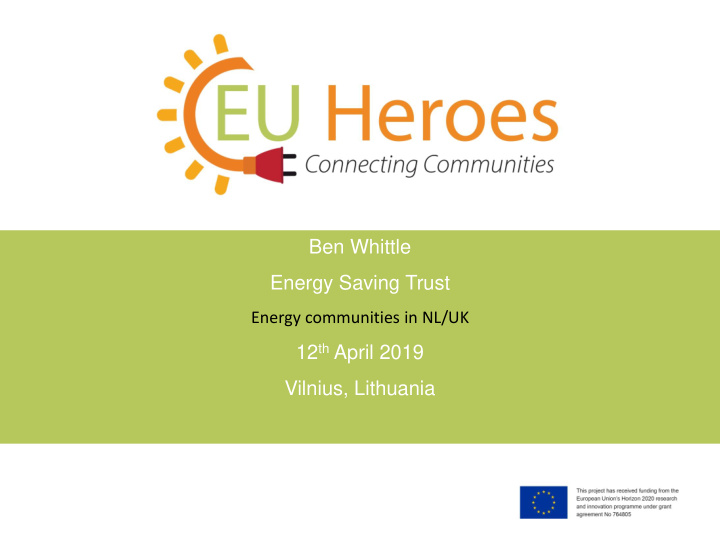



Ben Whittle Energy Saving Trust Energy communities in NL/UK 12 th April 2019 Vilnius, Lithuania
Status quo of energy communities 1995 -2010 • Very few projects • First project started with help from Sweden • Large wind projects, no generation tariff, significant stakes from combination of individual investors and banks • 10-30% of the wind turbines owned by a co-operative • Membership >1000 people
History of energy communities in the UK 1996 Baywind 5MW wind farm, 1200 members Baywind then created Energy4All who created the Westmill Co-Ops They then helped create Share Energy who have started over 30 more co-ops OVESCO have also helped create many more small schemes MW? KW MW Edinburgh Solar Solar for Schools Great Glen Co-Operative 100kW Harveys Brewery RePOWER ? 5MW Baywind Energy4All Share Energy OVESCO 50kW Pomona HALO Community Solar Westmill Wind CARE 250kW 1995 West Solent 6.5MW Westmill Solar EGNI 2005 Leominster School 80kW 2010 4 Winds 2015 2020 FiT start FiT reduction FiT Stop
Status quo of energy communities – last 8 years 2010 – 2018 • Small Co- ops started by a “parent” organisation • Solar becomes viable for the first time with the start of feed in and generation tariffs • Self consumption is not an important part of the profitability • Mostly owned by local people: <150 • Typically run with volunteers with administrative assistance provided by specialist charities • Offering a small return on investment: 4-6% • Many small co-operatives own a single asset on one building or in one location: 50 – 250kW
Future energy communities in the UK 2019 – onwards • Smaller Co-Ops no longer financially viable without generation tariff • New build PV only viable tariff free at scales greater than 10MW with very low install costs • Private wire / good PPA contracts essential • Aggregator models starting where multiple assets are owned by a single co-operative • Aggregators are buying assets and merging with existing co-operatives – not building • Larger scales planned for multiple buildings, not single buildings
Main Challenges For solar in the UK: Generation tariffs were not managed proactively to target uptake in areas with the best resources so now some areas are too constrained Developers drain some of this money from the UK economy if they are managed by large international financial institutions rather than community or national assets
Main Challenges For community energy • Tariffs disappearing in the next year will dramatically reduce the number of buildings viable for community owned assets • Greater Legal costs and complexity with bigger co-ops • Generation capacity reserved by big developers means not much land is available • Self consumption and private wire arrangements increasingly important – also reducing available sites
Positive outcomes of change + Future co-operatives are likely to be better organised, stronger institutions + Community organisations will have more political and economic influence
Negative outcomes - Significantly lower growth of new build solar - Less volunteer / local community involvement – maybe this is a +?
Conclusions The government should enter into conversations with the electricity network management teams at the highest level, as early as possible, to plan where solar development occurs. Incentive schemes and electrical infrastructure improvements should be managed in a way that will suit everyone. Self-consumption is key to getting the best financial and electrical performance from solar installations, so they should be planned with this in mind. Heating and Cooling buildings is often a larger carbon impact than electricity usage, so building regulations should encourage low heating/cooling demands which can be managed with local solar generation where possible If community ownership is a desirable outcome, incentives should be better than for commercial ownership. Incentives should be planned with flexibility so that they can be changed gradually in a managed way. Good communication and engagement with service providers is essential.
Recommend
More recommend